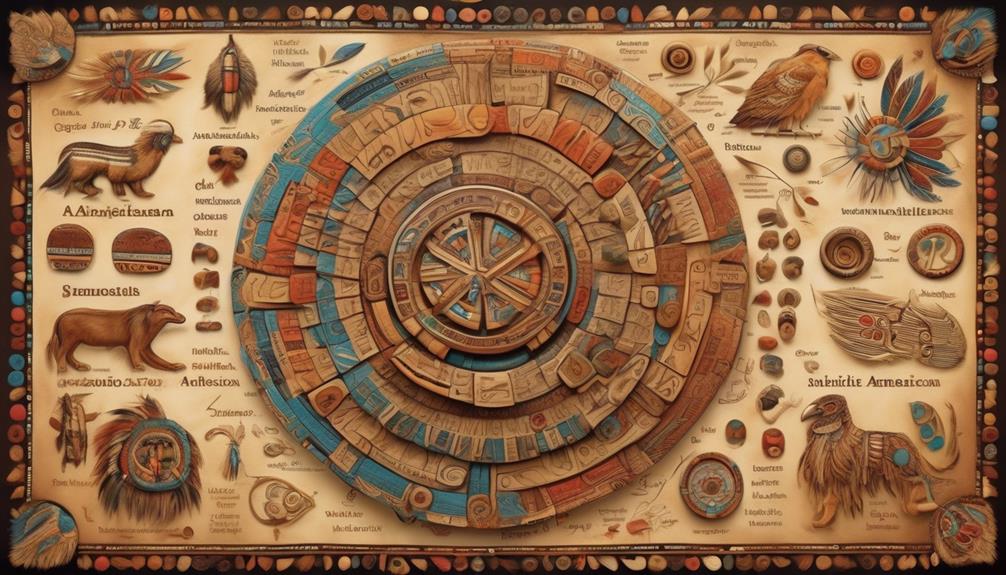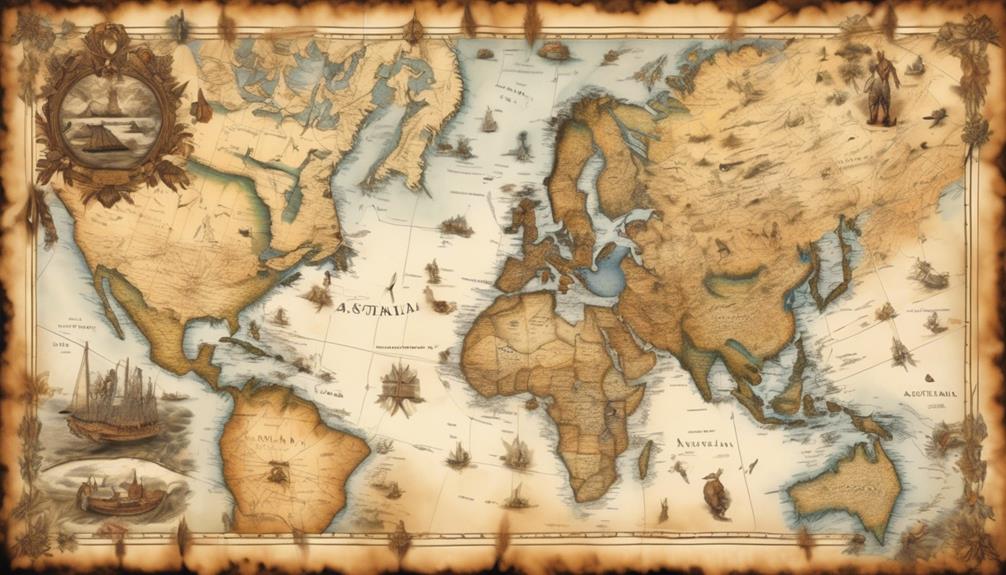When considering the impact of Europe on Aboriginal communities, it is clear that this historical interaction has resulted in significant and lasting effects.
The complexities of this interaction have shaped the course of history in ways that continue to reverberate through the present day. From the initial moments of contact to the enduring legacies that persist, the influence of Europe on Aboriginal peoples has been multi-faceted and far-reaching.
But what were the specific dynamics at play, and how did they unfold over time? It's a question that demands careful consideration and a nuanced understanding, as we unravel the intricate web of consequences that have shaped the lives of Aboriginal peoples.
Key Takeaways
- Imposition of European cultural norms and values, leading to the suppression of Aboriginal belief systems and the undermining of traditional leadership.
- Displacement of Aboriginal peoples from their ancestral lands, resulting in the breakdown of kinship networks and loss of land and resources.
- Economic exploitation and resource depletion, as European powers exploited Aboriginal labor and depleted natural resources vital to Aboriginal communities.
- Legal and political subjugation, with the imposition of foreign laws, disregard for traditional laws, and land dispossession through deceitful treaties, leading to the restriction of political rights and disenfranchisement of Aboriginal peoples.
Historical Context of European Contact
Upon the arrival of European explorers and settlers in the late 15th and early 16th centuries, the historical context of European contact with Aboriginal peoples in the Americas was marked by profound and enduring consequences. The encounter between these two distinct cultural groups led to a complex and multifaceted exchange of ideas, technologies, and traditions. This cultural exchange, however, was heavily influenced by the power dynamics at play.
European explorers and settlers, backed by advanced weaponry and a sense of cultural superiority, often sought to assert dominance over the Aboriginal peoples they encountered. This resulted in a significant imbalance of power, which shaped the nature of the cultural exchange.
The power dynamics inherent in the European-Aboriginal interaction had far-reaching effects on both groups. The Europeans, driven by notions of expansion and empire-building, sought to impose their own societal norms and values onto the Aboriginal communities. This led to the marginalization and suppression of indigenous cultures, languages, and belief systems.
Simultaneously, the Aboriginal peoples were forced to navigate a rapidly changing world, where their traditional ways of life were increasingly threatened by the encroachment of European settlers.
Socio-Cultural Disruption and Transformation

The arrival of European explorers and settlers significantly disrupted and transformed the socio-cultural fabric of Aboriginal communities in the Americas. This disruption led to a profound and lasting impact on the traditional way of life, belief systems, and social structures of the Aboriginal peoples. The imposition of European cultural norms, values, and institutions brought about a process of cultural assimilation, where the traditional knowledge and practices of the Aboriginal communities were devalued and, in many cases, actively suppressed. This had a profound effect on the socio-cultural dynamics within these communities, leading to a loss of cultural autonomy and identity.
| Socio-Cultural Disruption and Transformation | ||
|---|---|---|
| Disruption | Transformation | Impact |
| Imposition of European cultural norms | Loss of traditional knowledge | Devaluation of traditional practices |
| Suppression of Aboriginal belief systems | Adoption of European social structures | Erosion of cultural autonomy |
| Undermining of traditional leadership | Integration of European languages | Loss of indigenous identity |
| Displacement from ancestral lands | Introduction of new economic systems | Marginalization of traditional livelihoods |
| Breakdown of kinship networks | Shift towards individualistic values | Fragmentation of community cohesion |
The disruption and transformation of socio-cultural norms had lasting implications, reshaping the identity and social cohesion of Aboriginal peoples. It is crucial to recognize these historical realities and their ongoing consequences in order to understand the complexities of contemporary Aboriginal societies.
Economic Exploitation and Resource Depletion
The impacts of Europe on Aboriginal communities' socio-cultural fabric inevitably correlate with the subsequent economic exploitation and resource depletion experienced by these peoples. As European powers expanded their influence, resource extraction from Aboriginal lands became a central economic objective. This led to the ruthless exploitation of Aboriginal labor and the depletion of natural resources vital to their traditional ways of life.
Resource extraction, driven by European economic interests, significantly altered the Aboriginal peoples' relationship with their environment. The demand for timber, minerals, and other natural resources led to widespread deforestation, soil degradation, and disruption of ecosystems. These changes not only impacted the availability of essential resources for Aboriginal communities but also threatened the sustainability of their traditional economic activities, such as hunting, fishing, and gathering.
Moreover, the economic exploitation of Aboriginal labor further exacerbated the resource depletion. European settlers often coerced or forced Aboriginal people into labor-intensive industries, such as mining, agriculture, and logging, without fair compensation or consideration for their well-being. This exploitation not only depleted the labor force of Aboriginal communities but also disrupted their social structures and traditional economic systems.
The consequences of economic exploitation and resource depletion continue to reverberate in Aboriginal communities today, as they grapple with the long-term impacts of environmental degradation and the loss of traditional economic practices. Understanding the historical dynamics of resource extraction and labor exploitation is crucial for comprehending the enduring challenges faced by Aboriginal peoples in economic and environmental spheres.
Legal and Political Subjugation

European colonization systematically imposed legal and political subjugation on Aboriginal peoples, shaping their governance structures and rights within their own lands. This subjugation had a profound impact on the indigenous communities, and its repercussions are still felt today.
- Imposition of Foreign Laws: European powers enforced their legal systems upon indigenous communities, often disregarding the traditional laws and customs of the Aboriginal peoples. This led to the erosion of indigenous governance structures and the imposition of foreign systems that favored colonial domination.
- Land Dispossession: Legal mechanisms were utilized to dispossess Aboriginal peoples of their lands. Treaties were often deceitfully negotiated, and land rights were frequently disregarded, leading to widespread dispossession and displacement of indigenous communities.
- Restriction of Political Rights: Aboriginal peoples were often denied political representation and participation in the decision-making processes that affected their lives. This disenfranchisement further entrenched colonial dominance and subjugation.
- Indigenous Resistance: Despite the legal and political subjugation, indigenous communities actively resisted the imposition of foreign laws and governance structures. From legal challenges to armed uprisings, Aboriginal peoples engaged in various forms of resistance to protect their rights and sovereignty.
The legacy of legal and political subjugation continues to shape the relationship between Aboriginal peoples and colonial powers. Understanding this historical context is essential for addressing the contemporary challenges faced by indigenous communities and working towards reconciliation and justice.
Contemporary Challenges and Resilience
Contemporary challenges for Aboriginal peoples encompass a wide range of issues including social and economic disparities, cultural preservation, and community empowerment. In many Aboriginal communities, there are disproportionate rates of poverty, unemployment, and limited access to healthcare and education. These challenges are further exacerbated by historical traumas resulting from colonization, forced assimilation, and the intergenerational impacts of these policies.
Despite these adversities, Aboriginal peoples have shown remarkable resilience in various ways.
Cultural preservation is a significant challenge for Aboriginal communities in the face of globalization and modernization. The preservation of traditional languages, customs, and spirituality is crucial for maintaining cultural identity and connection to ancestral lands. Many Aboriginal groups have implemented cultural revitalization programs, language immersion initiatives, and traditional knowledge transmission efforts to ensure the continuity of their cultural heritage.
Furthermore, community empowerment has emerged as a key strategy for addressing contemporary challenges. Aboriginal communities have been actively involved in advocating for their rights, participating in decision-making processes, and engaging in economic development initiatives. Through community-led projects and partnerships, Aboriginal peoples have demonstrated their resilience by fostering sustainable development, promoting self-governance, and advocating for social justice.
Frequently Asked Questions
How Did European Contact Impact the Spiritual Beliefs and Practices of Aboriginal Peoples?
European contact significantly impacted the spiritual beliefs and practices of Aboriginal peoples. The introduction of Christianity and forced cultural assimilation led to the erosion of traditional spiritual systems. Many Indigenous practices were suppressed or prohibited, leading to a loss of cultural identity and connection to ancestral traditions.
This impact on spirituality reflects the broader consequences of European colonization on Aboriginal communities, shaping their worldview and cultural heritage.
What Were the Long-Term Effects of Economic Exploitation on the Traditional Livelihoods of Aboriginal Communities?
The impact on livelihoods resulting from economic exploitation and cultural assimilation had long-term effects on Aboriginal communities.
Economic exploitation disrupted traditional livelihoods, leading to loss of self-sufficiency and cultural erosion.
This forced cultural assimilation further undermined the autonomy of Aboriginal peoples.
The lasting consequences of these disruptions are still felt today, shaping the social and economic realities of Aboriginal communities.
How Did Legal and Political Subjugation Impact the Traditional Governance Systems of Aboriginal Societies?
Legal and political subjugation profoundly impacted the traditional governance systems of aboriginal societies. The imposition of European laws and governance structures eroded indigenous autonomy and cultural traditions, leading to a loss of self-governance and decision-making power.
Cultural assimilation policies further weakened indigenous governance by undermining traditional leadership and decision-making structures. These impacts continue to shape the challenges faced by aboriginal communities in reclaiming and revitalizing their governance systems.
What Role Did European Diseases Play in the Decline of Aboriginal Populations and Communities?
European diseases had a devastating impact on aboriginal populations and communities. The introduction of diseases such as smallpox, influenza, and measles caused widespread illness and death among indigenous peoples who had no immunity. This led to a significant decline in population and weakened traditional social structures.
Additionally, the spread of diseases contributed to cultural assimilation as communities struggled to cope with the loss of elders, knowledge, and social cohesion.
How Have Contemporary Challenges Affected the Preservation of Aboriginal Languages and Traditional Knowledge?
Preservation challenges for aboriginal languages and traditional knowledge are significant.
For example, language revitalization efforts in my community face barriers due to limited resources and lack of institutional support.
The loss of language has profound cultural and social repercussions. It undermines intergenerational transmission of traditional knowledge.
As a result, preserving and revitalizing aboriginal languages is crucial for maintaining cultural identity and strengthening community resilience.
Conclusion
In conclusion, the impact of Europe on Aboriginal peoples has been profound and enduring. One striking statistic is that in the 19th century, the Aboriginal population in Australia declined by 90% due to diseases and conflicts brought by European settlers. This illustrates the devastating consequences of European contact on Indigenous communities.
Despite these challenges, Aboriginal peoples have shown resilience and continue to fight for their rights and cultural preservation in the face of ongoing struggles.









